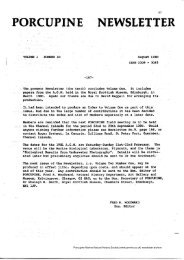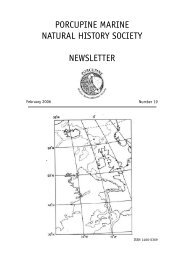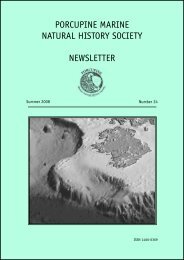Porcupine Newsletter Number 25, Winter 2008/09.
Porcupine Newsletter Number 25, Winter 2008/09.
Porcupine Newsletter Number 25, Winter 2008/09.
Create successful ePaper yourself
Turn your PDF publications into a flip-book with our unique Google optimized e-Paper software.
In Europe the swordfish have probablydeclined even more, but they are still caughtin the Mediterranean and Atlantic. Vesselsfishing for tuna in the Bay of Biscay and tothe south and west of Ireland occasionallycatch swordfish which are sometimes landedat Newlyn, in Cornwall.They do occur as far north as Sweden,and there are scattered records of swordfisharound Britain since the first one at Margatein 1841. There are few Scottish records withonly four or five in the twentieth century.They are probably commonest on the south andwest coasts, but do turn up in the North Sea.Records held by the National Marine Aquariumshow that in 2006 one was photographednear Teignmouth, in Devon and another seenleaping off Dorset, while a small (26 kg) onewas caught off the Northumberland; while inAugust 2007 an even smaller one was caughtsouth of the Lizard.The first swordfish in Wales was offNewport back in 1905; while in 2003 one wasstranded at Rhossili on the Gower, but in spiteof efforts to rescue it, it died an hour later. Sothe present fish is the third that Mr Herdsonhas details of in Wales. The National MarineAquarium would welcome any other reports.Douglas Herdson, Information Officer atthe National Marine Aquarium in Plymouth,said “We have phenomenal life thriving inthe seas around the Britain, some of therichest areas being off the Welsh coast, westof Scotland and the South West. It is greatthat fish like the swordfish and sunfish arebeing seen along with the turtles, dolphinsand basking sharks. We have wonderfulmarine biodiversity and must celebrate andprotect it.”The UK Marine Fish Recording Schemewelcomes reports of any unusual marine orestuarine fish seen around the British Isles;‘phone 01752 275216 or email fishreports@national-aquarium.co.uk.Rare ocean travellerPress release from National Marine AquariumContact: Douglas Herdson, InformationOfficer, National Marine Aquarium, Rope Walk,Coxside, Plymouth PL4 0LF, UK Douglas.Herdson@national-aquarium.co.ukOr – Nadine Simpson, Marketing, Nadine.Simpson@national-aquarium.co.ukOut for an early morning walk on thesands of Saundersfoot, Pembrokeshire, with hisdog, on Wednesday 6 th August <strong>2008</strong>, fishermanGavin Davies saw a strange shape rollingaround as the waves pushed up the beach.On closer inspection he saw it was a billfish.With the help of four friends and a Landroverhe got it pulled up the beach to where it couldbe examined.Photo - Gareth DaviesAt this time they could see it was a marlinand contacted South Wales Sea FisheriesCommittee Officer Mark Hamblin to check itout. Mark was able to determine that it was aBlue Marlin (Makaira nigricans), a fish virtuallyunknown in British and Irish waters and thefirst ever recorded from the Welsh coast. Thislarge fish with a spear-like snout can grow upto 5 metres long and weigh over 660 kilos. TheWelsh fish was 2.75 metres and weighed about190 kg. It is not known what caused its deathbut the large numbers of dolphins around thearea at that time might have attacked it, butit also appeared slightly emaciated indicatingthat it may have been unwell, or simply unableto feed in the cooler British waters. Oncestranded it was attacked by scavengers thatopened up its belly.There are 11 species of marlin and sailfishworldwide, five of which have been seen inthe North East Atlantic, three having turned22PMNHS <strong>Newsletter</strong> No.24 Summer <strong>2008</strong>








